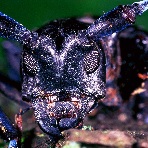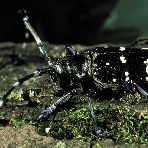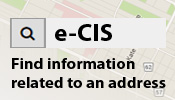Asian Longhorned Beetle
What are Asian Longhorned Beetles?

Asian Longhorned Beetles (ALHB) are a serious pests of hardwood trees. Tunneling in the wood by the larvae can girdle tree stems and branches. Repeated attacks lead to dieback of the crown and eventually, death of the tree.
Where do ALHB live?
They are native to Asia, but presently they are undergoing eradication efforts in New York City and Chicago areas.
What type of trees do they destroy?
Maple, poplar, willow, birch, elm, ash, and horse chestnut.
What do Asian Longhorned Beetles look like?

- The adult has a shiny black body (2 to 3.5 cm long) with white spots.
- Antennae are longer than the body with alternating black and white bands.
- Legs are black with pale bluish sections.
- Larvae and pupae are hidden inside the host tree within tunnels bored by the larvae.
How do I know a tree is being attacked by the ALHB?
- Round holes in the bark approximately 1 cm across, bored by the emerging adult.
- Oval to round pits or niches in the bark made by the adult female to deposit her eggs.
- Sap that oozes from the egg laying pits as the larvae feed.
- Accumulation of sawdust (from the boring larvae) around the base of infested trees as well where stems and branches meet.
What is the lifecycle of the ALHB?
ALHB usually has one generation per year depending on the regional climate. Eggs as well as larva and pupa can overwinter. Overwintering larvae begin to feed in March and pupate in June with emergence of the adult from host trees in June or July, remaining active into October. Adults can be seen actively feeding and mating in the tree canopy during sunny days from 8:00 to 14:00. Adults will feed on leaf stalks, leaves, young bark or twigs. The female adult can produce approximately 25-32 eggs, which she lays in niches or pits she excavates in the bark.
How does the beetle spread to other areas?
On its own, adults can fly hundreds of feet, which is increased when wind aided. More importantly people transporting infested firewood can unintentionally spread ALHB.
How can ALHB be controlled?
You can help control the ALHB by looking for signs of infested material in wood piles. If you plan on moving firewood, nursery stock or logs inspect them for signs of the ALHB. If you see signs do not move the infested material.
If you think you have found the ALHB you should:
- Record the location of the tree,
- Record the Signs and Symptoms you observed,
- Collect an adult specimen, keep it in a container in a freezer (to preserve it), and
- Contact the Canadian Food Inspection Agency or call 1-800-442-2342.


